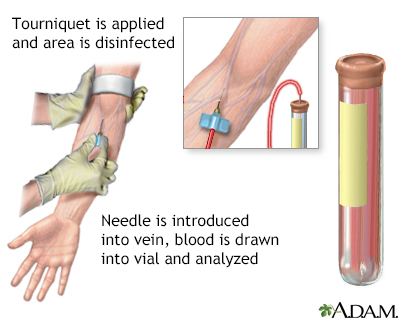How many times should an EDTA tube be inverted after blood collection?
5 to 7
2 to 4
1 to 3
8 to 10
The Correct Answer is D
Choice A Reason:
Inverting the tube 5 to 7 times may not be sufficient to mix the blood thoroughly with the EDTA. This could lead to partial clotting and potentially inaccurate test results. The EDTA anticoagulant works by binding calcium ions, which are necessary for blood clotting. Without adequate mixing, the EDTA may not be evenly distributed, leaving some areas of the blood sample able to clot.
Choice B Reason:
Inverting the tube only 2 to 4 times is inadequate for proper mixing. This minimal agitation would likely result in clot formation because the anticoagulant would not be sufficiently mixed with the blood. Clots can interfere with the accuracy of hematological tests by trapping cells and altering the specimen's composition.
Choice C Reason:
Inverting the tube 1 to 3 times is clearly insufficient and would almost certainly lead to clotting. The purpose of inverting the tube is to ensure that the EDTA coats all the blood cells, preventing coagulation. Such a low number of inversions would not allow for the anticoagulant to perform its function effectively.
Choice D Reason:
Inverting the tube 8 to 10 times is the recommended practice. This number of inversions ensures that the blood is fully mixed with the EDTA, preventing clot formation and preserving the integrity of the sample for accurate laboratory analysis. It is important to perform these inversions gently to avoid hemolysis, which can also affect test results. Hemolysis occurs when red blood cells are damaged and their contents leak out, which can happen if the blood is shaken too vigorously.
Nursing Test Bank
Naxlex Comprehensive Predictor Exams
Related Questions
Correct Answer is C
Explanation
Choice A reason:
Simply observing the site to see if the hematoma worsens is not an appropriate response. While monitoring the development of a hematoma is part of the process, it is not a proactive measure to address the immediate issue. The phlebotomist must take action to prevent further injury or complication.
Choice B reason:
Asking the patient to apply pressure may be part of the post-venipuncture care, especially after the needle has been removed, to aid in stopping any bleeding. However, this does not address the immediate concern of a developing hematoma during the draw.
Choice C reason:
Releasing the tourniquet and stopping the draw is the correct action to take when a hematoma is observed. This response is in line with the standard procedure for when a complication arises during venipuncture. Stopping the draw helps prevent further blood from pooling and exacerbating the hematoma.
Choice D reason:
While calling for a nurse and assessing the patient's condition is important, especially if the phlebotomist needs assistance or the patient shows signs of distress, it should not be the first action taken. The immediate response should be to address the hematoma by stopping the draw.

Correct Answer is C
Explanation
Choice A Reason:
Using only one patient identifier is not sufficient to ensure patient safety and accuracy in healthcare settings. It increases the risk of misidentification, which can lead to serious medical errors. Therefore, one identifier is not the standard practice for patient verification before a blood draw.
Choice B Reason:
While two identifiers are commonly used in many healthcare settings as a minimum requirement, they may not always provide enough differentiation, especially in larger facilities where patient names may be similar. Two identifiers are often the minimum standard, but they are not the most comprehensive approach.
Choice C Reason:
Three unique patient identifiers provide a more robust method for verifying a patient's identity, significantly reducing the likelihood of errors. According to the Clinical and Laboratory Standards Institute (CLSI), three identifiers are recommended to ensure the correct patient is being collected. This may include the patient's full name, date of birth, and medical record number or another unique identifier.
Choice D Reason:
While using four unique identifiers could further reduce the risk of patient misidentification, it is not typically required as the standard minimum. Three identifiers are generally considered adequate for most healthcare settings to ensure patient safety and proper identification.
Whether you are a student looking to ace your exams or a practicing nurse seeking to enhance your expertise , our nursing education contents will empower you with the confidence and competence to make a difference in the lives of patients and become a respected leader in the healthcare field.
Visit Naxlex, invest in your future and unlock endless possibilities with our unparalleled nursing education contents today
Report Wrong Answer on the Current Question
Do you disagree with the answer? If yes, what is your expected answer? Explain.
Kindly be descriptive with the issue you are facing.
